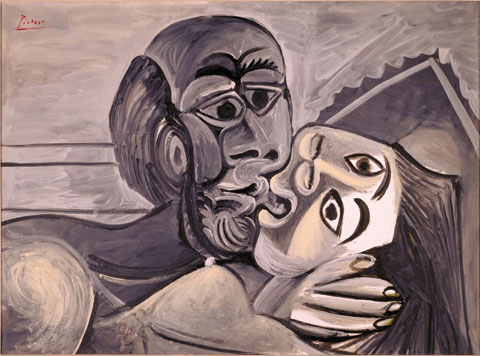The vast Raymond and Patsy Nasher Collection ranges from South American and Native American folkloric art to modern paintings, drawings, and sculptures.
It was a trip to Mexico more than 50 years ago and the purchase of some pre-Columbian pieces that sparked Raymond and Patsy Nasher’s interest in art collecting. Their mild interest quickly grew into fervent passion and ultimately manifested itself as one of the most internationally renowned collections of modern art.
The Nashers spent many years creating their collection, which began in 1961 after vacationing in Mexico when Patsy gifted Raymond with Jean Arp’s Torso with Buds for his birthday. Four years later, Raymond, a developer and banker, created Dallas’ NorthPark Center, the most ambitious retail shopping center at the time. He and Patsy committed to installing art throughout the mall, making the Nashers among the first developers to incorporate art in developments, a practice that still flourishes today.
During the ’80s, the Nashers collected works by virtually all the great masters, as well as pieces by contemporary artists, resulting in a diverse collection. By 1987, the collection had gained international recognition and was displayed in museums throughout the U.S. and Europe. In 2000, 12 years after his wife’s death, Raymond announced his plans for the development and funding of the Nasher Sculpture Center in Dallas. Upon Raymond’s recent passing, financial assets and portions of his art collection were bequeathed to the Nasher Foundation. In total, Raymond contributed an astounding $500 million to Dallas’ cultural life.
Elliot Cattarulla, the executive director of the Nasher Foundation, says, “It was Mr. Nasher’s intent that the items related to the core mission of the Nasher Sculpture Center be retained, and that those not vital to the center’s mission be sold in order to augment the financial resources he left as endowments. He began this process prior to his death, and as his estate is being settled, the Board of The Nasher Foundation will continue the process by consigning certain works of art to Sotheby’s for sale in their Spring 2008 New York auctions.”
Sotheby’s sales of pieces from the Nasher collection will take place in a series of four auctions, which will commence with an evening sale of Impressionist and Modern Art on May 7, followed by a single owner sale on May 9, a Contemporary Art sale on May 14, and a sale of American Paintings on May 22.
“The Nashers’ contribution to the worlds of art and architecture is remarkable and international, and their legacy is abiding in the works they collected and now share with the public,” says Warren Weitman, chairman of Sotheby’s North and South America.
Highlighting the series are two pieces by Picasso: Le Baiser, a 1929 oil on canvas (estimated $10 million to $15 million); and L’Atelier, a 1928 oil and black crayon on canvas (estimated $6 million to 8 million). Sotheby’s will present both pieces during the evening sale on May 7. Modern artists, such as Stuart Davis, Henri Matisse, and Jasper Johns, will also appear throughout the series.
During the May 9 single owner sale, Lichtenstein’s famous bronze Yellow Apple will appear alongside yet another Picasso masterpiece, the Buste de Jeune Femme d’Après Cranach le Jeune (estimated $325,000). The German Renaissance artist Lucas Cranach’s 1561 portrait, which hangs in the Kunsthistorisches Museum in Vienna, Austria, was Picasso’s inspiration for this particular piece.
Jasper Johns’ earliest lithography, Gray Alphabets, and his most ambitious lithographic endeavor, Black Numeral Series, will also appear during the sale. Both are estimated to realize well over $100,000, and other artists, such as Max Ernst, Henri Matisse, Joan Miró, and David Gilhooly, will be offered throughout the evening.
Only two Nasher Collection pieces will appear during the Contemporary Art sale on May 14. The first work, Hans Hofmann’s Gloria in Excelsis (estimated $3 million), is a perfect example of the artist’s “Push and Pull” theory, in which he used rectangular blocks to create a bold symphony of color. The second piece is Jean Dubuffet’s Conjugaison, a collage composed of several individual works on paper from the series Le Theatres de Memoires (estimated $2 million). For those that are more interested in American abstract art, several pieces by Stuart Davis will appear at the May 22 sale, including Composition with Winch (estimated $500,000), and Fortap (estimated $600,000). Both pieces reference the complexities of a working harbor as they allude to the equipment, ropes, derricks, shapes, and angles that Davis observed in the boatyards of Gloucester, Massachusetts.
The vast Raymond and Patsy Nasher Collection ranges from South American and Native American folkloric art to modern paintings, drawings, and sculptures. It depicts a distinct balance between early modern works and pieces from the post-war period-abstraction, figuration, and monumental outdoor works versus intimate, smaller scale indoor pieces.
The Nashers made art collecting an art. To own a piece from this collection is to own a work of art with twice the history-the history of the artist who created it, and the history of the collector and philanthropist who chose to add the piece to their artistically created collection.





















